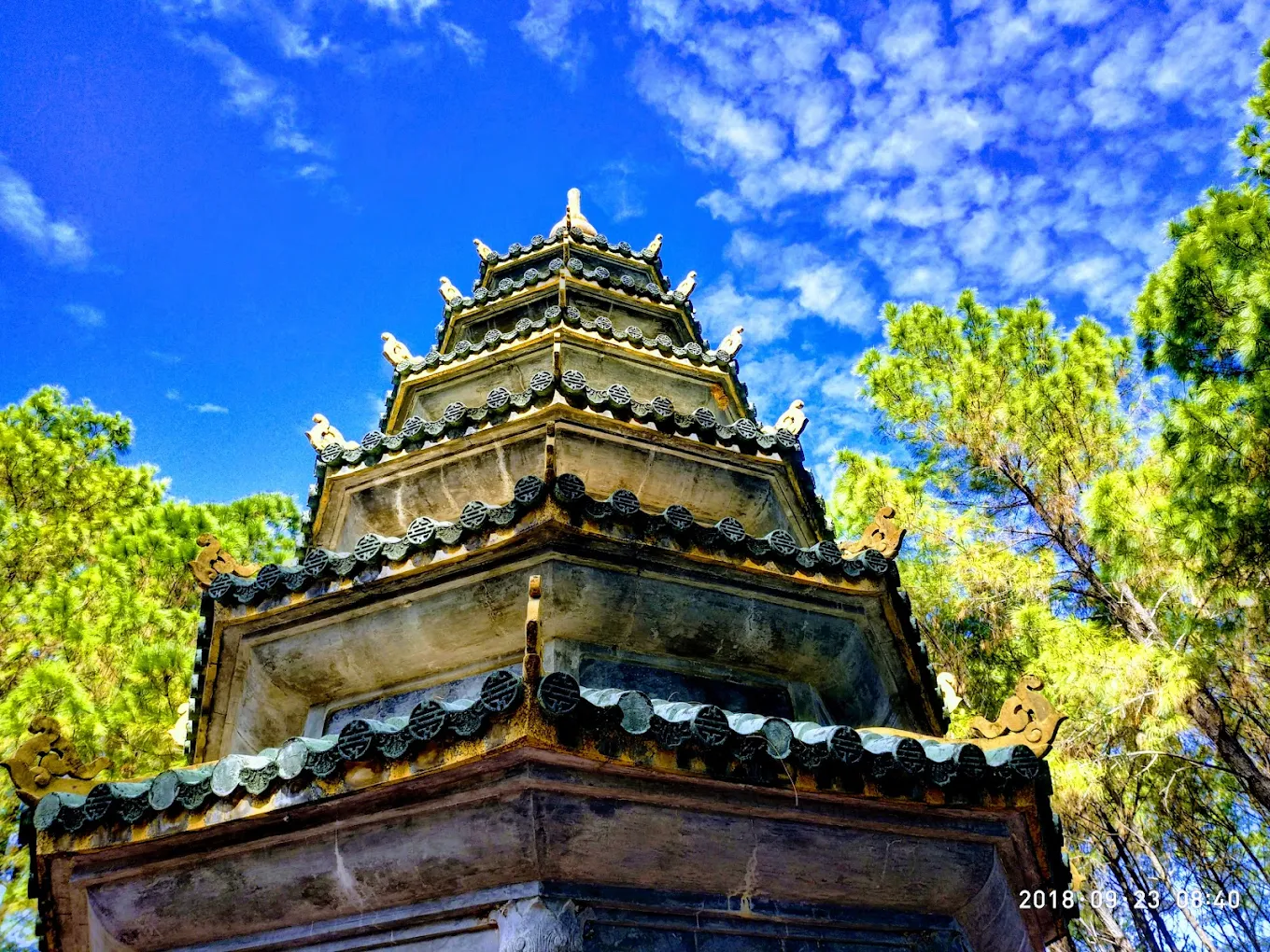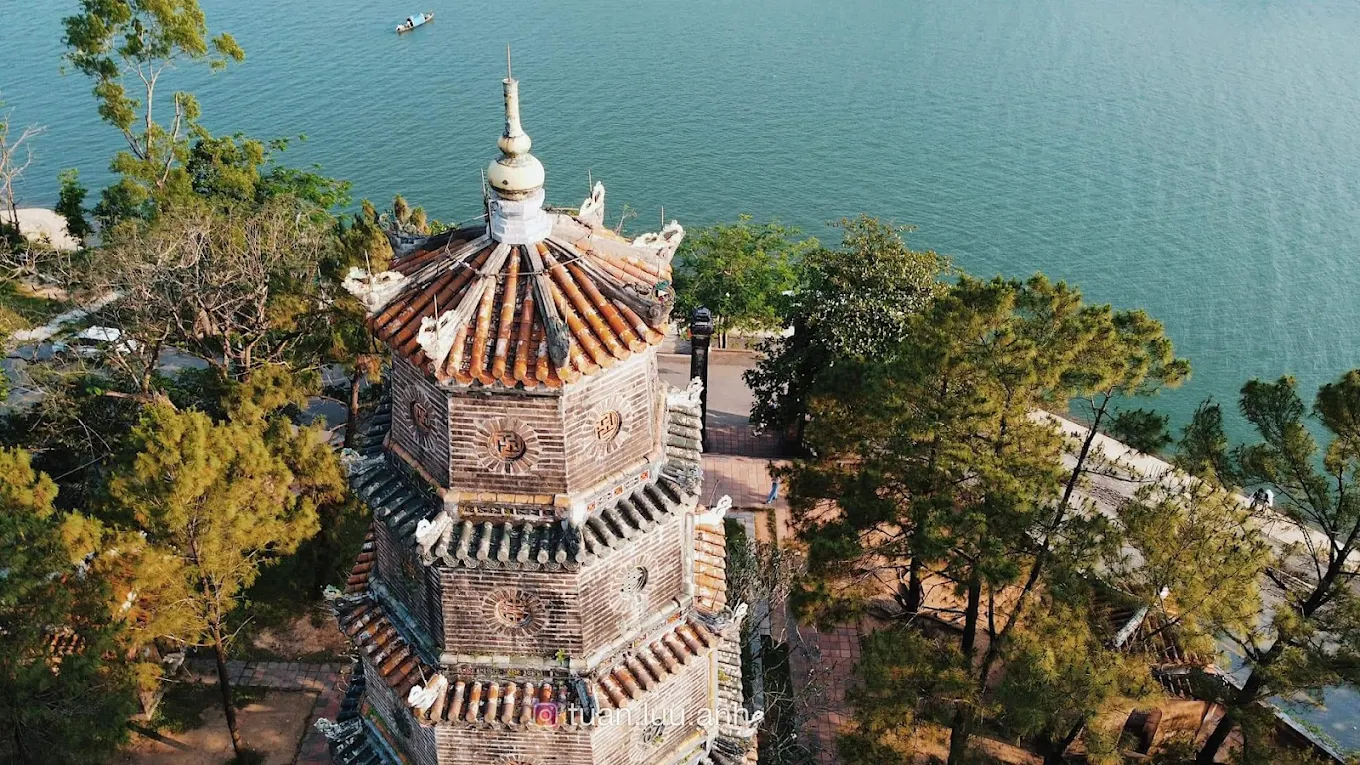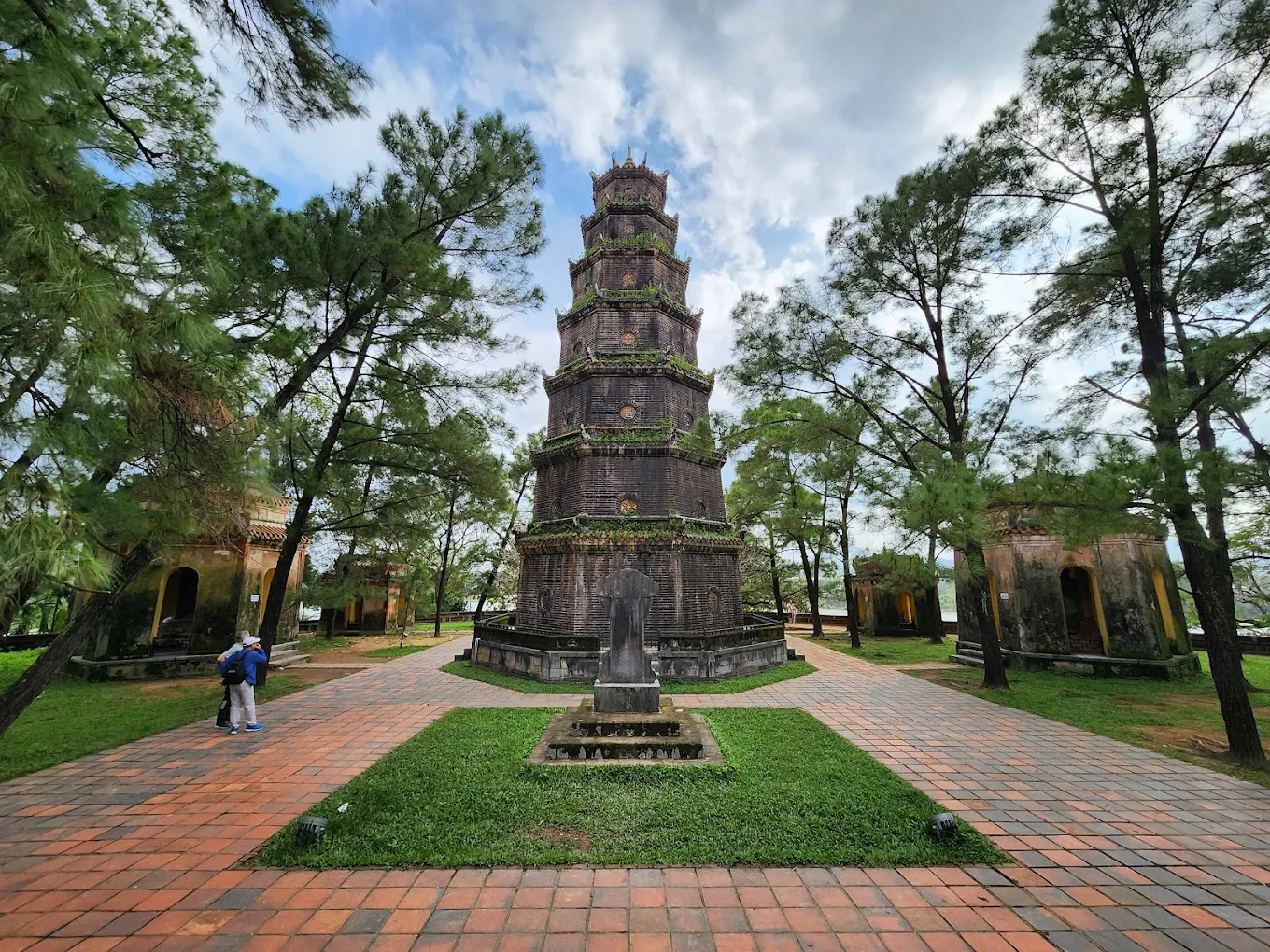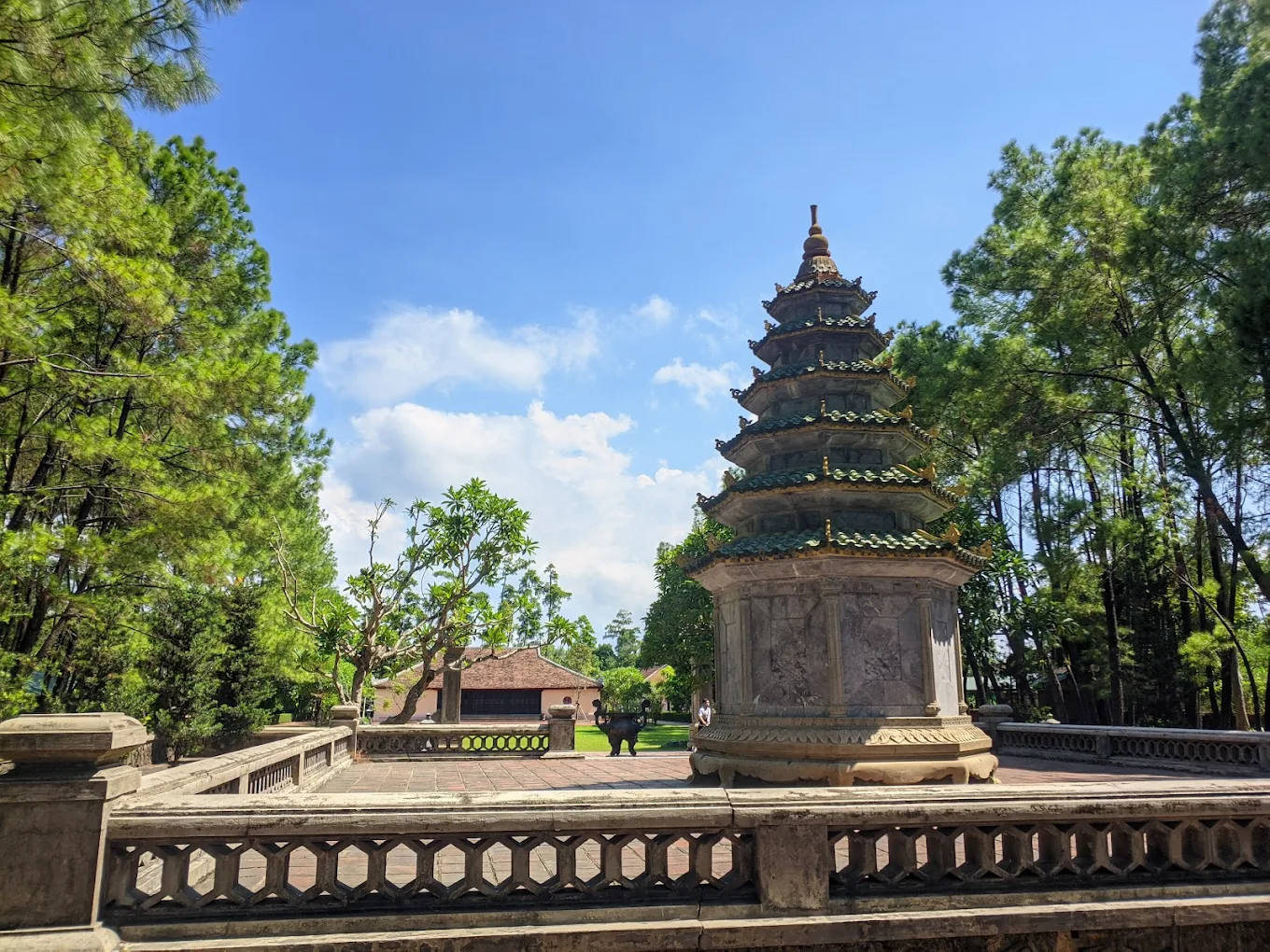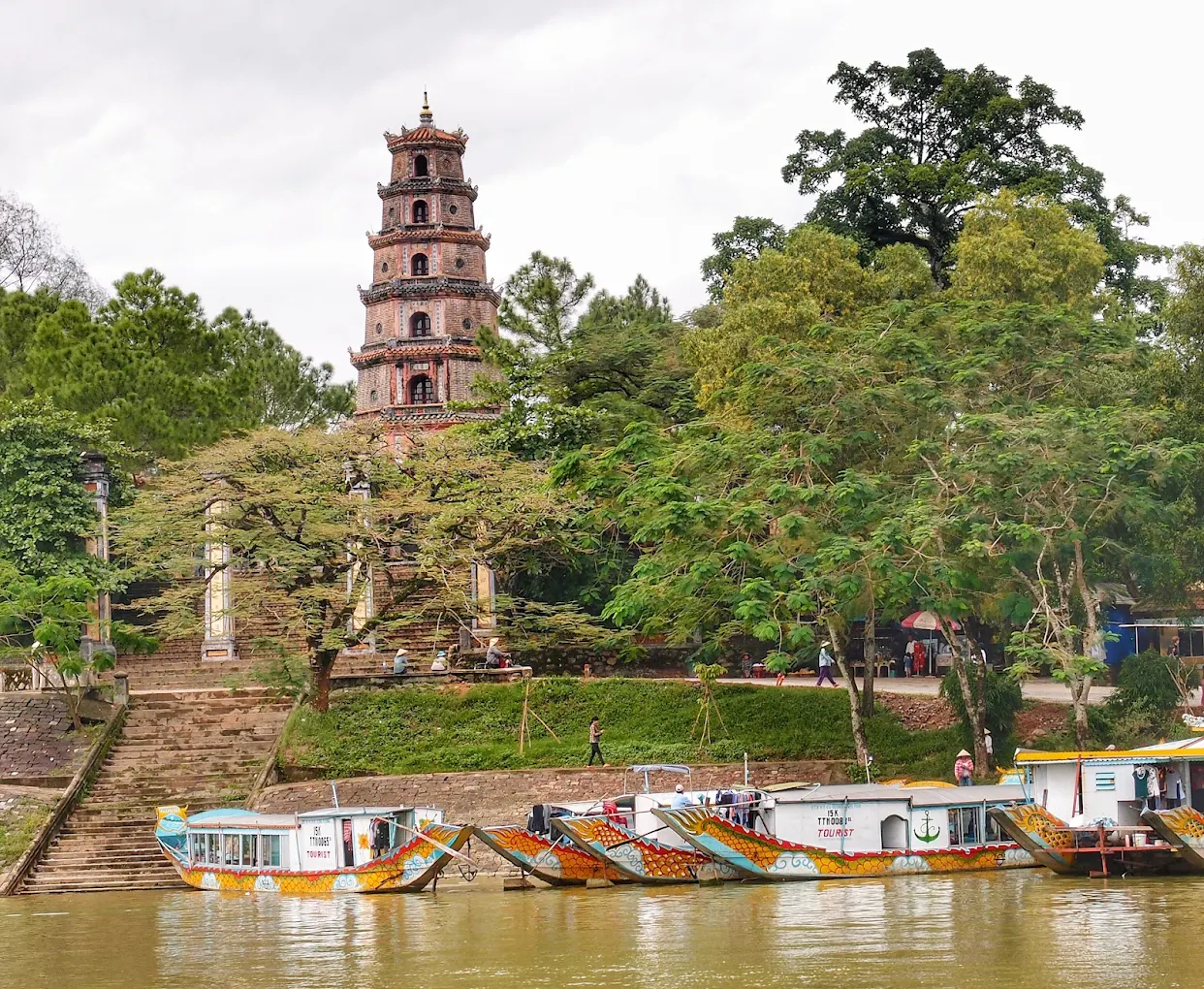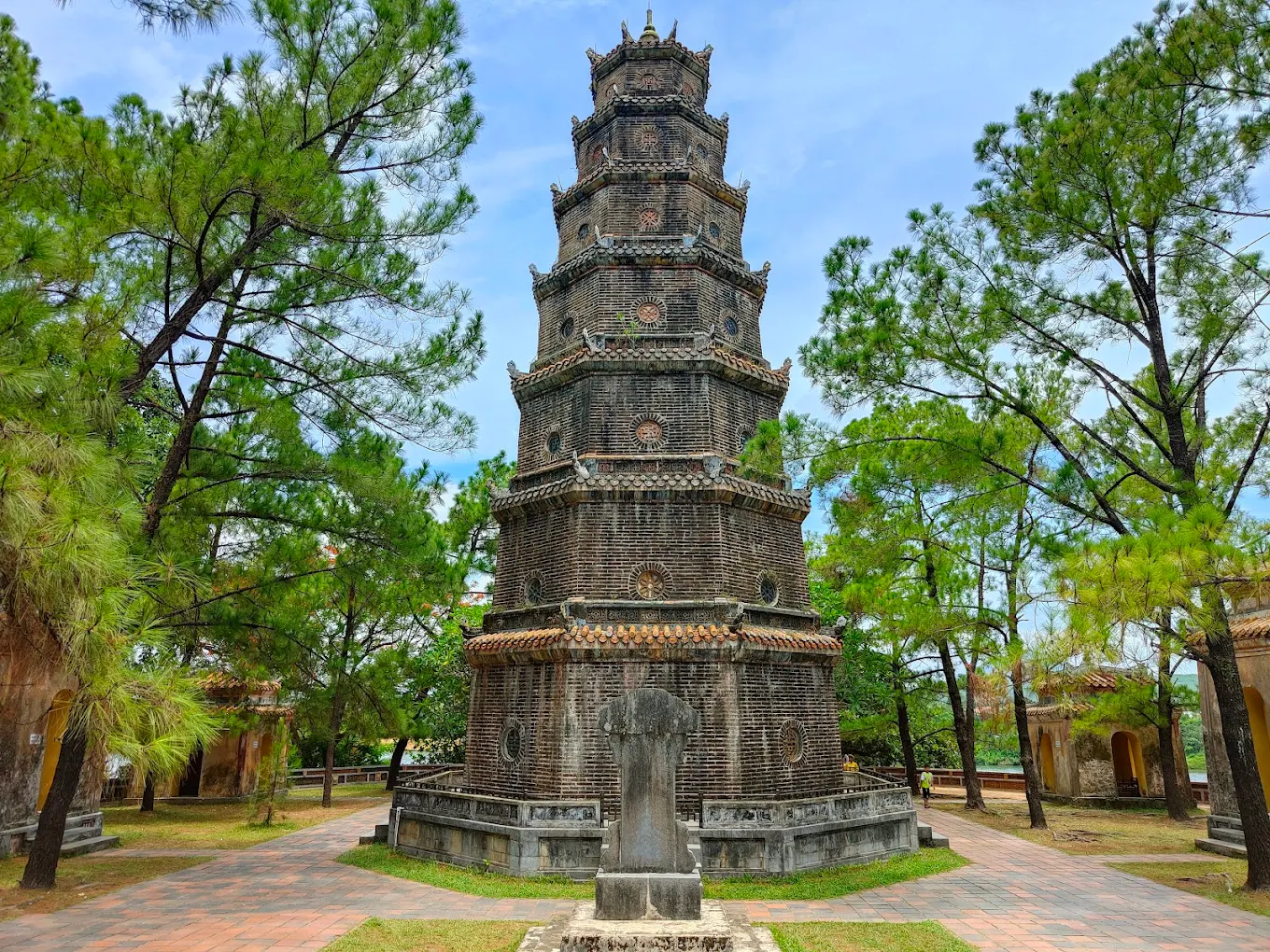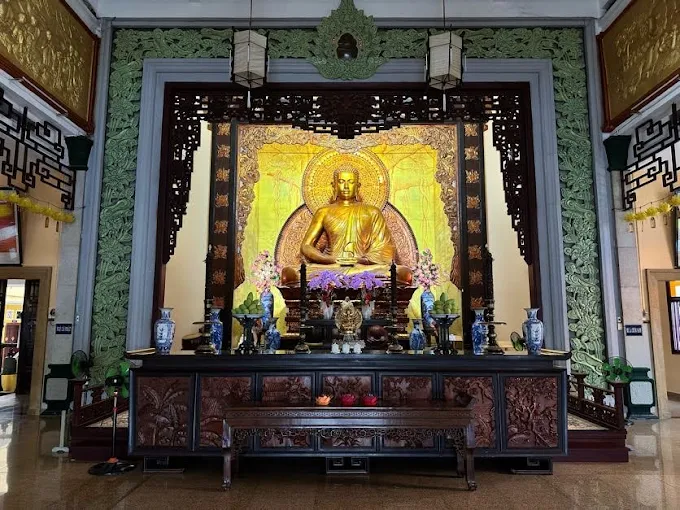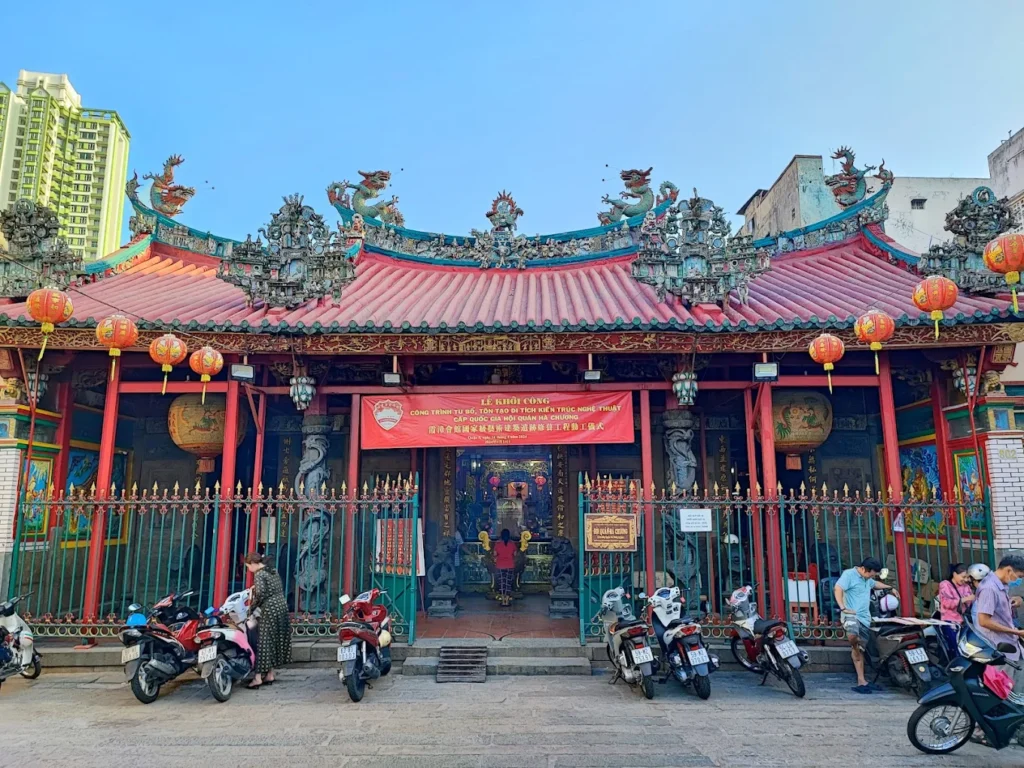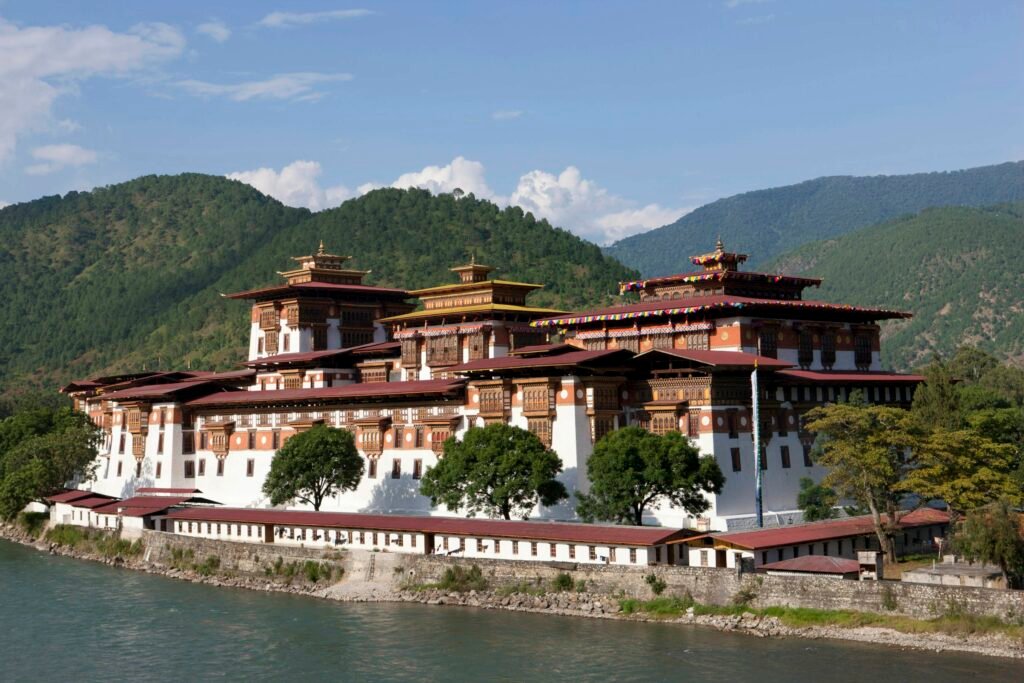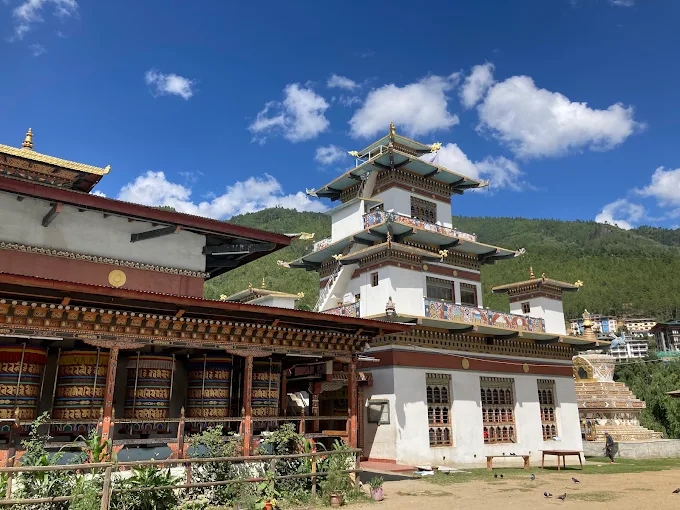Thiên Mụ Pagoda: The Celestial Serenity of Huế’s Riverside Sanctuary
Perched on Hà Khê Hill beside the Sông Hương, where lotus blossoms drift on gentle currents, Thiên Mụ Pagoda stands as a timeless beacon of Mahayana Buddhist devotion. In the main hall (chánh điện), monks chant sutras before a golden statue of Shakyamuni Buddha, their voices blending with the resonant toll of a 2-ton bronze bell. Founded in 1601 by Lord Nguyễn Hoàng, this sacred haven is crowned by its iconic seven-story Phước Duyên Tower, a symbol of Huế’s spiritual heart. The pagoda’s riverside gardens, shaded by ancient pines, hum with the whispers of history and prayer, inviting pilgrims to pause. Each incense stick lit honors the celestial lady (Thiên Mụ), whose legend inspired this sanctuary. From its hilltop, the Hương River unfurls like a silver thread, weaving serenity into the landscape. This sacred refuge beckons travelers, seekers, and scholars to explore Vietnam’s Buddhist soul, a living tapestry of faith and beauty.
Whispers of the River: Overview and Significance
Introduction to Thiên Mụ Pagoda
Thiên Mụ Pagoda, nestled on Hà Khê Hill in Huế’s Phường Hương Long, is a revered Mahayana Buddhist sanctuary, celebrated for its seven-story Phước Duyên Tower and tranquil Hương River setting. Known as the “Celestial Lady Pagoda,” it embodies Vietnam’s spiritual heritage, drawing pilgrims and visitors to its serene riverside grounds. The name “Thiên Mụ” honors a divine figure said to have guided its founding, symbolizing celestial protection. A cultural jewel, the pagoda blends history, art, and devotion, offering a haven for reflection amid Huế’s imperial legacy.
Historical Roots
Thiên Mụ Pagoda began in 1601, when Lord Nguyễn Hoàng, a Nguyễn Dynasty founder, built a shrine inspired by a celestial lady’s vision on Hà Khê Hill. By 1665, Lord Nguyễn Phúc Tần expanded it into a grand pagoda, adding the Phước Duyên Tower. Emperors like Thiệu Trị and Thành Thái later enriched its structures, embedding it in Huế’s royal narrative. Despite wars and floods, the pagoda endures, its 400-year legacy shaped by Buddhist monks and local devotion.
Cultural Resonance
- Mahayana Devotion: Rooted in Mahayana Buddhism, the pagoda centers on Shakyamuni and Avalokitesvara, guiding devotees toward enlightenment.
- Ethnic Vietnamese Heritage: A spiritual anchor for the Kinh community, it preserves rituals like sutra chanting and vegetarian feasts.
- Imperial Legacy: Its ties to the Nguyễn Dynasty make it a cultural landmark, reflecting Huế’s royal Buddhist patronage.
- Regional Influence: Festivals unite Buddhists from Thừa Thiên Huế and beyond, fostering shared devotion.
Unique Legacy
- Phước Duyên Tower: The seven-story tower, each level honoring a Buddha, stands as Huế’s most iconic structure.
- Riverside Serenity: The Hương River setting, with lotus-filled waters, enhances meditative calm.
- Celestial Legend: The tale of Thiên Mụ, a divine lady guiding Nguyễn Hoàng, infuses mystical allure.
- Enduring Symbol: Its resilience through history cements its role as Huế’s spiritual heart.
Community and Global Impact
- Local Devotion: The pagoda hosts Buddhist festivals, strengthening Kinh Buddhist bonds.
- Pilgrimage Hub: Thousands visit annually, drawn by its historical and spiritual weight.
- Global Appeal: International travelers seek its iconic tower and serene ambiance, placing it on Huế’s cultural map.
- Cultural Dialogue: Shared rituals unite local Buddhists with global visitors, fostering cross-cultural understanding.
Modern Relevance
- Spiritual Retreat: In a bustling world, Thiên Mụ Pagoda offers a haven for mindfulness.
- Cultural Preservation: It safeguards Mahayana practices, ensuring Huế’s Buddhist heritage thrives.
- Eco-Spiritual Harmony: Its riverside gardens promote environmental reverence, aligning with Buddhist ethics.
Historical Anecdotes
- Celestial Vision: Nguyễn Hoàng’s 1601 founding followed a divine lady’s prophecy, marking the site as sacred.
- Royal Patronage: Emperors rebuilt structures, embedding the pagoda in Nguyễn Dynasty lore.
- 1963 Protests: Monks here sparked Buddhist activism, shaping Vietnam’s modern history.
Social Role
- Community Hub: The pagoda unites Kinh Buddhists through festivals and rituals.
- Educational Center: Monks teach Buddhist principles, nurturing cultural values.
- Charitable Spirit: Vegetarian feasts during festivals reflect Mahayana’s generosity.
Artistic Influence
- Poetic Inspiration: The pagoda’s riverside beauty has inspired Huế’s poets and artists for centuries.
- Cultural Icon: Its tower graces artworks, symbolizing Huế’s spiritual identity.
- Festival Art: Ceremonial decorations, like lotus lanterns, showcase local craftsmanship.
Crafted by the River: Architectural and Spiritual Features
Iconic Design
Thiên Mụ Pagoda’s architecture marries Vietnamese Mahayana elegance with its Hương River setting, creating a majestic yet serene sanctuary. Stone walls and tiled roofs, adorned with dragon motifs, harmonize with Hà Khê Hill’s gentle slopes. The layout, centered on the main hall, follows Buddhist principles of balance, with gardens and courtyards inviting contemplation. Elevated above the Hương River, it offers sweeping views, infusing meditative tranquility.
Key Structures
- Main Hall (Chánh Điện): The spiritual core, with wooden beams and lotus carvings, houses the Shakyamuni statue.
- Phước Duyên Tower: The 21-meter, seven-story octagonal tower, built in 1844, symbolizes seven Buddhas.
- Courtyard: A stone-paved space with incense burners, shaded by pines, hosts communal prayers.
- Meditation Pavilion: An open structure by the river, ideal for silent reflection.
- Bell Tower: A stone structure with a 2-ton bronze bell, cast in 1710, resonates during ceremonies.
- Garden Shrine: A small altar for Avalokitesvara, nestled among lotuses, used for evening prayers.
- Tam Quan Gate: The ornate entrance, with dragon reliefs, welcomes pilgrims.
- Monastic Quarters: Modest buildings for monks, blending with the gardens.
Worshipped Statues
- Shakyamuni Buddha: A golden statue in the main hall, depicting meditation, symbolizes enlightenment.
- Avalokitesvara (Quan Thế Âm): A white marble statue, holding a nectar vase, radiates compassion.
- Địa Tạng and Maitreya: Bronze statues flank the altar, representing salvation and future hope.
- Spiritual Role: Devotees offer incense to Shakyamuni and Avalokitesvara, seeking wisdom and compassion.
Materials and Techniques
- Construction: Local stone and teak, joined with traditional Vietnamese techniques, ensure durability.
- Artistry: Dragon carvings and ceramic tiles, crafted by Kinh artisans, reflect Buddhist symbolism.
- Cultural Essence: The design blends Mahayana elegance with Huế’s imperial aesthetic, distinct from other regional styles.
Signature Elements
- Phước Duyên Tower: The seven-story tower, visible across the river, anchors the pagoda’s identity.
- Riverside Gardens: Lotus ponds and pines create a meditative haven.
- Bronze Bell: The 1710 bell’s deep tone resonates with spiritual significance.
Lesser-Known Features
- Stone Inscriptions: Tablets near the courtyard bear 17th-century prayers.
- Hidden Shrine: A small alcove for Patriarch Trần Nhân Tông hosts Trúc Lâm rituals.
- Ancient Pine: A 400-year-old pine, said to predate the pagoda, shades the courtyard.
Preservation Efforts
- Restoration (1990s): Roof repairs preserved ceramic tiles, maintaining imperial charm.
- Challenges: River floods and humidity erode stonework, requiring regular upkeep.
- Modern Additions: Solar-powered lanterns, added in 2023, light the grounds.
Environmental Integration
- Riverside Harmony: The design respects the Hương River’s ecosystem, preserving tranquility.
- Eco-Practices: Monks promote lotus planting, reflecting Buddhist environmental ethics.
- Wildlife Haven: The gardens shelter birds, enhancing meditative ambiance.
Artisan Narratives
- Tower Builders: 19th-century artisans from Huế crafted the Phước Duyên Tower’s intricate details.
- Bell Casters: The 1710 bell was forged by local metalworkers, a feat of craftsmanship.
- Tile Makers: Ceramic tiles, fired in Huế kilns, bear dragon patterns, symbolizing protection.
Symbolic Details
- Seven Stories: The tower’s levels represent stages of enlightenment.
- Lotus Ponds: Lotuses symbolize purity rising above worldly suffering.
- Dragon Motifs: Dragons on roofs signify imperial and divine protection.
Landscape Integration
- River Views: The pagoda’s orientation frames the Hương River, enhancing meditation.
- Hilltop Setting: Hà Khê Hill’s elevation symbolizes spiritual ascent.
- Garden Paths: Winding trails encourage mindful walking amid pines.
Rites of the Heart: Rituals and Practices
Daily Sacred Rites
- Morning Chanting: Monks recite the Heart Sutra at dawn, their voices echoing across the river.
- Meditation Sessions: Silent meditation, held twice daily, focuses on wisdom and compassion.
- Incense Offerings: Devotees light sandalwood incense before Shakyamuni, praying for peace.
Unique Practices
- Lotus Offerings: Devotees offer lotus flowers to Avalokitesvara, symbolizing purity.
- River Blessings: Monks chant by the Hương River, praying for community well-being.
- Signature Ritual: Ringing the bronze bell during ceremonies, its tone fostering mindfulness.
Festival Traditions
- Buddha’s Birthday (8th day, 4th lunar month): Lantern processions and statue bathing draw hundreds.
- Ullambana Festival: Candle-lit offerings honor ancestors, uniting families.
- Avalokitesvara’s Birthday: Flower processions celebrate compassion, with statues adorned in silk.
- Statue Veneration: Shakyamuni and Avalokitesvara are draped in robes during festivals.
Visitor Engagement
- Accessible Rituals: Visitors can join chants or offer incense, guided by monks.
- Offerings: Flowers and incense, available at the pagoda shop, invite participation.
- Buddhist Etiquette: Bow three times before statues, signaling respect.
Spiritual Community Roles
- Monastics: A group of monks leads rituals and teaches Buddhist principles.
- Lay Devotees: Kinh volunteers organize festivals and maintain grounds.
- Statue Care: Daily cleaning of statues reflects devotion.
Interfaith Connections
- Syncretic Practices: Some blend Buddhist prayers with folk beliefs, offering fruit to local deities.
- Outreach: Festivals host interfaith dialogues, welcoming diverse perspectives.
- Education: Monks offer talks on Mahayana principles for visitors.
Ritual Symbolism
- Lotus Offerings: Lotuses mirror purity transcending suffering.
- Bell Tone: The bronze bell’s resonance aligns mind and spirit.
- Chanting Rhythm: The Heart Sutra fosters mindfulness through cadence.
Seasonal Variations
- Spring Festivals: Vibrant with lotuses, ideal for Buddha’s Birthday.
- Autumn Rites: Cooler weather enhances calm during Ullambana.
- Monsoon Season: Chants under rain-soaked pines offer unique serenity.
Monastic Life
- Daily Routine: Monks rise at dawn for chants, meditation, and study.
- Community Service: Monks guide lay devotees in rituals and teachings.
- Training Hub: The pagoda trains young monks, preserving Mahayana traditions.
Journey to Tranquility: Visitor Information
Navigating to Thiên Mụ Pagoda
- Location: Đồi Hà Khê, Phường Hương Long, Huế City, Thừa Thiên Huế Province, 5 km from central Huế.
- Landmarks: Beside the Hương River, near Kim Long Village, with clear Vietnamese and English signs.
- Routes: Accessible by taxi, motorbike, or bicycle from Huế’s center, with a short walk to the hilltop.
Address of Thiên Mụ Pagoda
- Vietnamese: Chùa Thiên Mụ, Đồi Hà Khê, Phường Hương Long, Thành phố Huế, Tỉnh Thừa Thiên Huế.
- English: Thiên Mụ Pagoda, Hà Khê Hill, Hương Long Ward, Huế City, Thừa Thiên Huế Province.
Visiting Hours and Etiquette
- Hours: Open daily, 6:00 AM–5:00 PM, with extended hours during lunar festivals.
- Etiquette: Remove shoes before the main hall, speak softly, and dress modestly.
- Mahayana Custom: Offer incense with both hands and bow to statues.
Accessibility and Safety
- Mobility: Gentle slopes to the main hall are manageable; some areas may challenge mobility issues.
- Safety: Well-maintained paths and monastic presence ensure security.
- Tips: Wear sturdy shoes for garden paths and carry water.
Amenities and Surroundings
- Facilities: Restrooms and a shop offer incense, flowers, and Buddhist texts.
- Nearby: Kim Long Village and Vĩnh Nghiêm Pagoda, within 2 km, offer cultural experiences.
- Dining: Vegetarian stalls nearby serve mindful meals.
Immersive Visitor Tips
- Best Timing: Dawn visits offer serene chants and cooler temperatures.
- Sensory Moments: Inhale lotus-scented air and hear the bronze bell for deeper calm.
- Statue Connection: Offer incense to Avalokitesvara and meditate briefly.
- Festival Planning: Attend Buddha’s Birthday for vibrant processions.
Nearby Cultural Experiences
- Kim Long Village: Explore traditional Huế houses, 1 km away.
- Hương River Tours: Boat trips offer pagoda views from the water.
- Imperial Citadel: A 5-km ride reveals Huế’s royal history.
Transport Options
- By Taxi: A reliable choice from Huế’s center, with drop-off near the entrance.
- By Motorbike: Offers flexibility to explore nearby sites.
- By Bicycle: A scenic ride along the Hương River suits active visitors.
Photography Tips
- Best Angles: Capture Phước Duyên Tower at dawn for soft light.
- Respectful Shots: Avoid photographing monks during prayers without permission.
- Scenic Views: The riverside offers stunning Hương River shots at sunset.
- Equipment: A smartphone or lightweight camera suffices.
Deepening the Experience: Cultural and Spiritual Insights
Mahayana Philosophy
Thiên Mụ Pagoda embodies Mahayana’s core: compassion and wisdom as paths to enlightenment. Shakyamuni and Avalokitesvara inspire devotees to act with kindness, reflected in vegetarian feasts. “Emptiness” underscores interconnectedness, encouraging release of ego.
Riverside Spirituality
The Hương River ties the pagoda to Huế’s spiritual life, with monks chanting for community well-being. Lotus offerings symbolize purity amid life’s flux. The riverside pavilion invites prayers that blend with the river’s flow, deepening connection.
Artistic Symbolism
Dragon motifs signify divine protection, while lotuses symbolize purity. The Phước Duyên Tower’s seven stories reflect stages of enlightenment. These elements invite contemplation of resilience and wisdom.
Community Resilience
The pagoda reflects Kinh perseverance, built by Nguyễn lords and sustained by monks. Volunteer-led festivals continue this spirit, making it a symbol of unity.
Environmental Stewardship
The riverside gardens foster Buddhist environmental ethics. Lotus planting and a bird-friendly ecosystem enhance meditation. Visitors are urged to tread lightly, honoring nature.
Meditative Practices
Mahayana meditation visualizes Avalokitesvara’s compassion. The riverside pavilion, guided by monks, offers a quiet space for inner peace, amplified by the Hương River’s calm.
Cultural Narratives
- Celestial Tale: The Thiên Mụ legend fuels devotion, linking past and present.
- Monastic Stories: Monks share tales of royal patrons and 1963 protests.
- Festival Lore: Buddha’s Birthday chants carry centuries-old traditions.
Historical Context
- Nguyễn Dynasty: The pagoda’s royal ties shaped Huế’s Buddhist culture.
- Buddhist Activism: 1963 protests here influenced Vietnam’s spiritual history.
- Artistic Legacy: The tower inspired Huế’s poetry and paintings.
Practical Planning for Pilgrims
Optimal Visit Seasons
- Spring (February–April): Mild weather and blooming lotuses enhance visits, with Buddha’s Birthday adding vibrancy.
- Autumn (September–November): Cooler temperatures offer clear river views.
- Avoid: Summer (June–August) brings rain, making paths slippery.
Packing Essentials
- Clothing: Lightweight, modest attire (long pants, covered shoulders).
- Footwear: Sturdy sneakers for paths, with socks for barefoot entry.
- Supplies: Water bottle, towel for humidity, notebook for reflections.
- Offerings: Incense or flowers, available at the shop, for rituals.
Connecting with the Community
- Monastic Guidance: Approach monks for Mahayana insights; some speak basic English.
- Festival Participation: Join vegetarian feasts to bond with locals.
- Volunteer Opportunities: Inquire about lotus planting or upkeep events.
Mindful Exploration
- Pacing the Visit: Wander gardens slowly, reflecting on each view.
- Quiet Observation: Sit by the river to absorb the pagoda’s calm.
- Journaling: Record thoughts in the pavilion for deeper insight.
Cultural Immersion
- River Contemplation: Meditate by the Hương River, aligning with its flow.
- Festival Engagement: Observe lantern processions to feel Huế’s spirit.
- Monastic Interaction: Listen to monks’ stories for historical context.
Reflecting on the Journey
Thiên Mụ Pagoda is a sanctuary where the heart finds refuge beside the Hương River. The Phước Duyên Tower, piercing the sky, embodies wisdom that transcends time, inviting all to heed the celestial lady’s call. Its gardens, worn by centuries of pilgrims, tell a story of resilience, faith, and unity, rooted in Huế’s Mahayana soul. Whether meditating before Shakyamuni, gazing at the river’s flow, or tracing imperial threads, visitors find a space to reflect and reconnect. As you leave, the bell’s echo and lotus scent linger, a reminder that serenity is always within reach.

